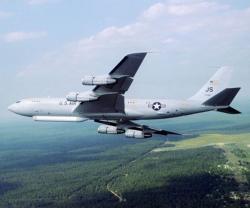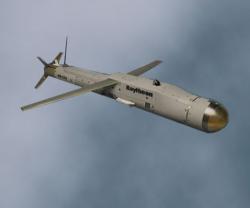“Working together with the Army, we will deliver with IBCS a fully netted system providing a single, unambiguous view to enable any-sensor, best-shooter capability. Today's successful intercept test demonstrated the power of the IBCS to conduct net-centric engagements with componentized sensors and launchers,” said Dan Verwiel, Vice President and General Manager, Integrated Air and Missile Defense division, Northrop Grumman Information Systems.
The flight test began when a ballistic missile serving as a threat surrogate flew against a defended asset. The defense consisted of battery and battalion IBCS engagement operations centers, a Patriot radar and two adapted Patriot launchers connected at the component level to the IBCS integrated fire control network. Using measurement data from the Patriot radar, the IBCS track manager established a composite track on the ballistic missile. The IBCS mission control software assessed the track as a threat and presented an engagement solution. The engagement operations center operator then commanded, via the IBCS mission control software, launches of two Patriot PAC-2 interceptor missiles to destroy the target.
Army Air Defense Artillery School Commandant and Air Defense Artillery Chief Brig. Gen. Christopher L. Spillman said: “The enormous complexity of the air battle we face today and tomorrow demands we give commanders much greater flexibility to organize sensors and shooters. IBCS is the centerpiece of how we achieve that and a revolutionized IAMD.”
Foundational to IAMD transformation and key to the Army IAMD portfolio, the IBCS is managed by the IAMD Project Office, Program Executive Office for Missiles and Space, Redstone Arsenal, Alabama.
Northrop Grumman has been the IBCS prime contractor since 2010 and has 300 program personnel located in Huntsville, Alabama; Dahlgren, Virginia; Colorado Springs, Colorado; Melbourne, Florida; Los Angeles and San Diego. The company's IBCS development, integration and test activities take place in multiple Huntsville laboratories and facilities. For the flight test, several IBCS engagement operations centers and integrated fire control network relays were deployed to White Sands Missile Range. In addition, engagement operations centers and relays were utilized in Andover, Massachusetts, for flight test analysis.
IBCS replaces seven legacy command-and-control (C2) systems to provide a single integrated air picture, reduce single points of failure and offer the flexibility for deployment of smaller force packages. By networking sensors and interceptors – as opposed to simply linking them – IBCS provides wider area surveillance and broader protection areas. With its truly open systems architecture, IBCS enables integration of current and future sensors and weapon systems and interoperability with joint C2 and the ballistic missile defense system.






















